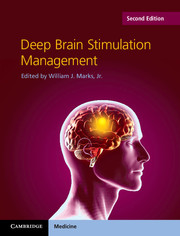Book contents
- Deep Brain Stimulation ManagementSecond edition
- Deep Brain Stimulation Management
- Copyright page
- Dedication
- Contents
- Contributors
- Preface
- Glossary
- Chapter 1 Introduction
- Chapter 2 Patient selection
- Chapter 3 Surgical placement of deep brain stimulating leads for the treatment of movement disorders – intraoperative aspects: physiological mapping, test stimulation, and patient evaluation
- Chapter 4 New techniques for deep brain stimulation lead implantation
- Chapter 5 Principles of neurostimulation
- Chapter 6 Fundamentals of deep brain stimulation programming
- Chapter 7 Managing essential tremor patients treated with deep brain stimulation
- Chapter 8 Managing Parkinson's disease patients treated with deep brain stimulation
- Chapter 9 Managing dystonia patients treated with deep brain stimulation
- Chapter 10 Managing epilepsy patients treated with deep brain stimulation
- Chapter 11 Managing patients with psychiatric conditions treated with deep brain stimulation
- Chapter 12 Assessing patient outcome and troubleshooting deep brain stimulation
- Chapter 13 Implementing deep brain stimulation in practice: models of patient care
- Appendix A: Motor diary
- Appendix B: Unified Parkinson's Disease Rating Scale
- Appendix C: Abnormal Involuntary Movement Scale
- Appendix D: Unified Dyskinesia Rating Scale (UDysRS)
- Appendix E: PDQ-39 questionnaire
- Appendix F: Montreal Cognitive Assessment Test – English
- Appendix G: Geriatric Depression Scale
- Appendix H: Fahn–Tolosa–Marin Tremor Rating Scale
- Appendix I: Burke–Fahn–Marsden Dystonia Rating Scale
- Appendix J: Toronto Western Spasmodic Torticollis Rating Scale
- Appendix K: GPi DBS programming data sheet
- Appendix L: STN DBS programming data sheet
- Appendix M: Vim DBS programming data sheet
- Appendix N: DBS programming flow sheet
- Appendix O: Modified Antidepressant Treatment History Form
- Appendix P: Cognitive–Behavioral Treatment History Form
- Index
- References
Chapter 11 - Managing patients with psychiatric conditions treated with deep brain stimulation
Published online by Cambridge University Press: 05 September 2015
- Deep Brain Stimulation ManagementSecond edition
- Deep Brain Stimulation Management
- Copyright page
- Dedication
- Contents
- Contributors
- Preface
- Glossary
- Chapter 1 Introduction
- Chapter 2 Patient selection
- Chapter 3 Surgical placement of deep brain stimulating leads for the treatment of movement disorders – intraoperative aspects: physiological mapping, test stimulation, and patient evaluation
- Chapter 4 New techniques for deep brain stimulation lead implantation
- Chapter 5 Principles of neurostimulation
- Chapter 6 Fundamentals of deep brain stimulation programming
- Chapter 7 Managing essential tremor patients treated with deep brain stimulation
- Chapter 8 Managing Parkinson's disease patients treated with deep brain stimulation
- Chapter 9 Managing dystonia patients treated with deep brain stimulation
- Chapter 10 Managing epilepsy patients treated with deep brain stimulation
- Chapter 11 Managing patients with psychiatric conditions treated with deep brain stimulation
- Chapter 12 Assessing patient outcome and troubleshooting deep brain stimulation
- Chapter 13 Implementing deep brain stimulation in practice: models of patient care
- Appendix A: Motor diary
- Appendix B: Unified Parkinson's Disease Rating Scale
- Appendix C: Abnormal Involuntary Movement Scale
- Appendix D: Unified Dyskinesia Rating Scale (UDysRS)
- Appendix E: PDQ-39 questionnaire
- Appendix F: Montreal Cognitive Assessment Test – English
- Appendix G: Geriatric Depression Scale
- Appendix H: Fahn–Tolosa–Marin Tremor Rating Scale
- Appendix I: Burke–Fahn–Marsden Dystonia Rating Scale
- Appendix J: Toronto Western Spasmodic Torticollis Rating Scale
- Appendix K: GPi DBS programming data sheet
- Appendix L: STN DBS programming data sheet
- Appendix M: Vim DBS programming data sheet
- Appendix N: DBS programming flow sheet
- Appendix O: Modified Antidepressant Treatment History Form
- Appendix P: Cognitive–Behavioral Treatment History Form
- Index
- References
- Type
- Chapter
- Information
- Deep Brain Stimulation Management , pp. 124 - 137Publisher: Cambridge University PressPrint publication year: 2015
References
- 10
- Cited by

